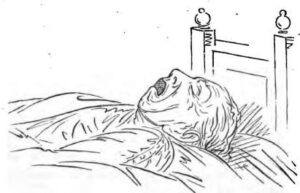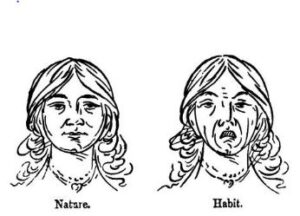Nature Cure Clinical Pearls
Sussanna Czeranko, ND, BBE
In civilized communities, better sheltered, less exposed, and with the aid of the ablest professional skill, the sanitary condition of mankind, with its variety, its complication, and fatality of diseases, its aches and pains, and mental and physical deformities presents a lamentable and mournful list, which plainly indicates the existence of some extraordinary latent cause, not as yet sufficiently appreciated, and which it is the sole object of this little work to expose.
George Catlin, 1870, p.4
Naw-kaw, Chief of the Winnebagos, in Wisconsin, … our women never die in childbirth, and they do not allow doctors to attend them on such occasions.
Chief Naw-kaw, 1870, p.15
The [First Nations] infant, like the offspring of the animal, breathing the natural and wholesome air, generally from instinct, closes its mouth during its sleep.
George Catlin, 1870, p.19
The miracle of childbirth is joyful, but also much bruised by unpleasant and sometimes tragic events and practices. Women have tragically died in childbirth at many points in human history, and high infant mortality has been part of the human condition for eons, most particularly before hygienic practices were understood and adopted. Due to slipshod codes for water, sewage, and waste at the end of the 19th century, women did not always have access to healthy drinking water, and sanitary disposal of sewage was often lacking. Even fashionable dress such as the corset had the effect of crippling the natural birthing process and sometimes even making healthy birthing impossible. Moreover, although the unrelenting medicalizing of childbirth in that era brought with it wonderful safeguards, it also led eventually to the highest maternal mortality rate in the developed world. Many women became increasingly alienated from their own bodies as the traditions of midwifery, found in multiple cultures around the globe, were curtailed in an increasingly allopathic landscape. In any case, here in North America, given the loud and proud pronouncements about healthy birthing because of all the advances made in medical protocol and practice, one would think that these tragedies of the past were long behind us. The intriguing observations of an early 19th century writer and artist, George Catlin, pointed out, well over a century and a half ago, how lifestyle, including breathing practices, had a significant impact on these birth and child mortality statistics.
To be sure, in many ways we have come far in women’s health, supported not only by a deeper understanding of the complexities of birth, but also by assurances of the steady advance of public health standards, an abundance of medical doctors, hospitals in every city and county, and a pharmaceutical industry committed to treating every ailment known to humankind. Here in America there are those who laud the remarkable translational research enterprise and point to hugely effective emergency and acute care. However, it is here that we have also evolved the most expensive healthcare or disease monitoring system in the entire world. How, then, in such a monetized and hi-tech, hi-pharma world, could we possibly benefit from the past regarding pregnancy and childbirth? Let’s review some current, worrying trends related to birthing and infant mortality.
Inexcusable Statistics
A 2015 Lancet-published study, for example, reported the 2013 US maternal death rate at 18.5 deaths per 100 000 live births. In the following year, another Lancet study cited a dramatic rise in American women’s risk of maternal mortality, increasing to 26.4 deaths per 100 000 live births. (Kassebaum et al, 2016, p.1784) These numbers establish American women as the most susceptible group among all developed countries to die in childbirth. Journalist Susan Perry writes, “American women are dying during pregnancy and childbirth at twice the rate they were 30 years ago.” (Perry, 2015) Shedding even more light on the surprising statistics revealing the high mortality rate in the birthing room, Scientific American journalist, Dina Fine Maron, showed that racial discrepancies in America’s birthing rooms were a significant factor in the data as well. Maron reports, “Researchers have shown that black women are not inherently more likely to have underlying pregnancy complications [such as preeclampsia, eclampsia, obstetric hemorrhage, placental abruption, and placenta previa]. Yet, black women were two to three times more likely to die than white women with the same complication.” (Maron, 2015) While preeclampsia accounts for 50 to 70 (per 100 000) women dying each year in the United States, in the United Kingdom there were only 2 deaths (per 100 000) from preeclampsia between 2012 and 2014. (Exstrum, 2018) The birth safety disparity is alarming between the US and the UK, despite the population variance (330 million in US; 65 million in UK).
In fact, American women face 8 times the incidence of maternal mortality than all other developed countries. Not only does “the United States have the highest maternal mortality rate [MMR] in the developed world, it is the only country where the rate of deaths from childbirth is increasing.” (Exstrum, 2018) The MMR is based upon the number of maternal deaths for every 100 000 live births. These alarming statistics are cause for concern because American women who are privileged with the best medical system are experiencing a higher risk of dying during childbirth than those women receiving what has been described as marginal healthcare, giving birth in Iran [MMR of 20.8], for example, or China [MMR, 17.7]. (Krassebaum et al, 2016)
The unarguable truth is that pregnancy and childbirth are not diseases but rather natural biological processes that are intricately and intimately part of human existence. How is it that we have not mitigated the risks and vulnerabilities in such a universal and common process as childbirth? In this regard, it is very instructive, when considering this non-rhetorical question, to harken back to Catlin’s recondite book that has faded with history but is so worthwhile to revisit: Shut your Mouth and Save your Life (1860).*
Shut Your Mouth and Save Your Life
An odd and even humorous title, Catlin’s work is a remarkable document. George Catlin [1796-1872] is well known for his early 19th century colossal work in which he produced a massive narrative about Native American populations, hugely enhanced by hundreds of paintings and portraits of those communities. His canon of work is now housed in the Smithsonian Museum. His book has emerged over time as a definitive early study about the dangers of mouth breathing, and it offers proper breathing habits, especially during sleep (Figure 1). But his book reveals far more that is urgently needed if only we heed the advice documented over 160 years ago by this remarkable adventurer-author-artist. Just who was Catlin, and did the early Naturopaths know about him? Indeed they did.
Figure 1. Mouth Breathing During Sleep

Catlin began as a lawyer and later became an artist and an anthropologist of sorts. Sometime later he became concerned about correcting the biases and prejudices rampant about the indigenous cultures in North America. He was an artist with the yearning commitment and diligence of an ethnographer covering the expanse of the entire North and South American continent in his quest to gather data about of the customs and habits of the First Nations. He visited over 2 million people in 150 tribes, who were at that point relatively untouched by the diseases and influences of the white man. He recorded on canvas their portraits and their vibrant way of life. What began as a mission to dispel the misconceptions that whites harbored against native populations, ended as a transformative revelation and a book based upon his observations and findings. He wanted facts and data that he saw with his own eyes, to convince his fellow countrymen that these indigenous cultures deserved to be honored and protected and even emulated, particularly about health. Sadly, his vision would not be realized.
However, his book, Shut Your Mouth and Save Your Life, would be reprinted many times. Significantly, it was noticed by the early Naturopaths as they examined the confounding etiologies of disease. The function of the nose is certainly to breathe air, which it is admirably designed to do. The nose warms, humidifies, and purifies the air that we breathe. Theodore Hoppe, a Naturopath in the early days, wrote an article on the importance of nasal breathing, in the November 1903 issue of The Naturopath and Herald of Health: “As guardian of health the nose … performs invaluable services in preventing diseases of the lungs, as it frees the inhaled air from impurities. … All breathing should, therefore, be through the nose, and none whatever should be done through the mouth.” (Hoppe, 1903, p.334) (Figure 2)
Figure 2. Nasal Breathing During Sleep

The early Naturopaths condoned and promulgated the importance of nasal breathing; it was Catlin’s book, as it turns out, that revealed the full breadth of benefits that he found during his journey across North and South America. Some of his revelations are still astonishing.
Culture Arrogance and Prejudice
What Catlin pointed out to the early Naturopaths through his work was that despite the seeming sophistication and technological superiority of European culture, indigenous peoples had much to teach us. The ethnocentric views of the white settlers, who unrelentingly populated the American landscape, also included tragic misappropriation of disadvantaged cultures. The common belief was that civilized people not only lived in comfort, but also lived longer and were less burdened by life’s hardships. In contrast, the indigenous people were thought to be uncivilized, primitive, and to live miserably short lives. In setting the record straight, Catlin writes:
I have visited these semi-civilized degradations of Savage life in every degree of latitude in North America, and to a great extent also in Central and South America. … I agree with those writers who have contended in general terms, that premature mortality is proportionally greater amongst the Native Races than in Civilized communities; but as I have also extended my visits and my inquiries into the tribes in the same latitudes, living in their primitive state, and practicing their native modes, I offer myself as a living witness, that whilst in that condition, the Native Races in North and South America are a healthier people and less subject to premature mortality (save from the accidents of war and the chase, and also from smallpox and other pestilential diseases introduced amongst them) than any civilized race in existence. (Catlin, 1870, p.7)
Catlin shocked his contemporaries, and certainly also gets our attention in the modern era, with such observations. He makes the point that living in the 19th century, with all the presumptuous perks and benefits accrued to a “civilized culture,” also entailed huge costs to community, health, and the environment, when compared to the footprint in those categories of the “savages” roaming the American continent. London, England, was viewed as the center of European civilization in the 19th century. Europeans, and especially the British, had built world empires, and championed the industrial revolution. The sun never set on the British Empire, it was said, so expansive around the globe were the colonies of Queen Victoria in that era.
Catlin uses the mortality statistics documents of the “Bills of Mortality” in London (from the office of the Registrar General) to illustrate the high death rate of the British urban population: “In London and other large towns in England and cities of the continent, on average, one half of the human race dies before they reach the age of five years, and one half of the remainder dies before they reach the age of 25, thus leaving but one in four to share the chances of lasting from the age of 25 to old age.” (Catlin, 1870, p.4) In 1850, living in this epicenter of civilization, the average citizen had a 25% probability of living past 25 years of age.
As an ethnographer, Catlin had set out to obtain reliable information about the tribes that existed in the Americas. He wanted to juxtapose what he knew about Europe (and specifically, England) with the vagaries and vicissitudes of life and health in the wilds of America. He writes, “Amongst a people who preserve no Records and gather no statistics, it has been impossible to obtain exact accounts of their annual deaths, or strict proportionate estimates of deaths before and between certain ages; but from verbal estimates given me by the Chiefs and Medical Men in the various tribes, … there has been no doubt I have been able to obtain information on these points which may safely be relied on.” (Catlin, 1870, p.7)
Catlin observed some 2 million tribes people. He noted that among these people infant mortality was also rare, and that if children died, the death was often associated with accidents – for example, drownings, or falling off a horse. As a case in point, when visiting the “Tribe of 2,000” on the upper Missouri who were reportedly “living entirely in their primitive state, [Catlin] leaned from the Chiefs that the death of a child under the age of 10 years was a very unusual occurrence.” (Catlin, 1870, p.10) He also writes, “Amongst two million of these wild people whom I have visited, I never saw or heard of a hunch back, though my inquiries were made in every Tribe; nor did I ever see an Idiot or Lunatic amongst them, though I heard of some three or four, during my travels and perhaps of as many deaf and dumb.” (Catlin, 1870, p.12) Not all of the tribes were so blessed to be immune from high child mortality rates, however. Once the Tribes were contaminated with whiskey and alcohol, the children began to die or be born “weakly.”
“Cler-mont, the Chief of the Osages, replied to [Catlin’s] questions: “Before my people began to use fire water, it was a very unusual thing for any of our women to lose their children; but I am sorry to say that we lose a great many of them now.” (Catlin, 1870, p.14) The white man’s gifts of alcohol ignited doom and misery for the recipients.
Death during childbirth was almost completely unheard of in Indian villages where the traditional ways had not been disrupted. “Sleepy Eyes, a celebrated chief of a Band of Sioux … living between the headwaters of the Mississippi and Missouri Rivers, … [revealed to Catlin] that in his Band of 1,500 he could not learn from the women that they had lost any of their children except some two or three who had died from accidents.” (Catlin, 1870, p.9)
Compared with European civilization at that time, fear of dying during childbirth was a real possibility faced by women. Maternal deaths in the 18th century were either caused by puerperal fever or sepsis or resulted from an incidental illness such as phthisis, typhoid, or pneumonia during pregnancy or after delivery. (Loudon, 1986, p.1) Irvine Loudon cites the maternal mortality in England and Wales between 1847 and 1850 to be 5.8 deaths per 1000 births, as compared to the contemporary statistic of 2015 maternal mortality rates of .009 per 1000 births. (Loudon, 1986; Kassebaum et al, 2016, p.1785)
Catlin’s scrupulous observations documented uncontestable patterns. While civilized populations experienced many premature deaths among women and children, and suffered mental and physical deformities, Catlin reported on “the superb health of children and lack of evidence of early death among children of natives living in their traditional ways.” (Henderson, 2009) Not only did native children not die during early childhood, but their physical attributes were also astonishingly healthy. By way of contrast, the literature shows that the children of “civilized” cultures during the time of Catlin’s writing exhibited deformities and changes in facial bone structures.
Weston Price, a century later, would write profusely on these same changes as traditional cultures adopted processed foods such as sugar and refined foods. Nancy Henderson, writing for the Weston Price Foundation, notes the uncannily parallel life-work of these 2 remarkable men. She writes, “As a pioneering anthropologist, Catlin recorded his observations of the physical characteristics of the Native Americans, which are remarkably similar to Dr. Price’s observation 100 years later in his classic book, Nutrition and Physical Degeneration.” (Henderson, 2009) An interesting side note is that Catlin was struck by the life-long perfection of teeth formation among all ages that he visited, along with the lack of any need of dentistry.
The Perils of Mouth Breathing
As artist, Catlin left behind drawings of what he saw among these people whom he grew to know and love. Studying his astonishing array of illustrations and paintings, one cannot fail to notice the differences between the indigenous people and their fellow humans in European centers of civilization. Later, we would witness the same startling contrasts in the photographs produced by Dr Price of indigenous populations and of their European counterparts. People in civilized cultures had distinct facial deformities consisting of retracted chins, narrow and elongated faces, crooked teeth, and a displeasing countenance.
Based upon his observations, what Catlin witnessed was that the indigenous people breathed with their noses and kept their mouths closed, except for eating and talking. This habit of keeping the lips closed began with the infant in the cradle. Catlin notes: “I have seen an Indian woman in the wilderness, lowering her infant from the breast, and pressing its lips together as it falls asleep, and fixing its cradle in the open air.” (Catlin, 1870, p.18) This and similar habits of mothers with their children engendered a lifetime habit of keeping the mouth closed and breathing with the nose. In comparison, the civilized whites, when sleeping with the mouths open, changed the facial structure, causing a retraction of the chin and “derangement and deformity of the teeth, and the disfigurement of the mouth and the whole face.” (Catlin, 1870, p.47) Catlin, as artist, illustrated these detrimental changes in his book (Figure 3). Humans, he noted, were the only animals that sleep with their mouths open.
Figure 3. Facial Deformity from Mouth Breathing


Mouth breathing chronically has been associated with a host of consequences, as documented by Dr Alan Ruth as the following (Ruth, 2015):
- Introduction of unfiltered, poorly humidified air into the lungs
- Upper chest breathing
- Chronic over-breathing
- Greater incidence of snoring and sleep apnea
- Bad breath, dental decay, gum disease
- Dysfunction of the temporomandibular joint
- Narrowing of the dental arch, jaw and palate
- Crowded and crooked teeth
- Open bite, malocclusion
- Greater potential for relapse of orthodontic corrections
- Dysfunctions of the muscles around the jaw and lips
- Loss of lip tone, with the lips becoming flaccid
- Noisy eating, speech and swallowing problems
- Trauma to soft tissues in the airways
- Enlarged tonsils and adenoids
When we apply these tabulations to a single person, we can handily correlate the same conclusion as Catlin, as witnessed by his drawings of chronic mouth-breathers. Catlin easily concluded that nasal breathing had many benefits. Since his writings, there are over 30 different benefits attributed to nasal breathing. (Ruth, 2016)
Nasal breathing related to pregnancy and childbirth can be understood by the roles of oxygen and carbon dioxide. For oxygen to be available to the tissues, carbon dioxide levels must be adequate. With chronic mouth breathing, there is a disproportionate loss of carbon dioxide which results in a reduction of oxygenation to the tissues. Nasal breathing increases oxygen levels but also the retention of carbon dioxide needed to facilitate oxygenation. By maintaining oxygenation, healthy nasal breathing helps to prevent hypoxia. During hypoxic episodes, one experiences muscle spasms, metabolic acidosis, and increased cellular stress. Nasal breathing during childbirth prevents huge swings in oxygen available to the tissues.
Hypoxia during childbirth can cause fetal stress and complicate the birth process. Nasal breathing helps to normalize the pH of the body and reduce any muscular stress that results from the lack of oxygenation. Although, this brief explanation may not adequately address the physiological basis of Catlin’s observations, there is strong evidence that nasal breathing was one of the chief factors in why the indigenous mothers did not experience harm.
“Catlin’s humanitarian drive compelled him to devote the last 12 years of his life until his death in 1872, to seeing that Shut Your Mouth, Save Your Life was continually revised and republished.” (Henderson, 2009) Catlin’s book continues to draw attention from those interested in understanding the value of breathing correctly to attain the best health. The book’s title was demonstrative, but his conclusions that nasal breathing can have a tremendous impact on our health is valuable advice a century and a half later.
*Note: George Catlin’s book, The Breath of Life or Mal-Respiration, and its Effects upon the Enjoyments and Life of Man, first published in 1861 by John Wiley in New York, was re-published in 1862 by Truebner in London with the title, Shut Your Mouth and Save Your Life.
References:
Catlin, G. (1870). Shut your mouth and save your life. London, England: N. Truebner & Co: 102.
Exstrum, O. (2018). It’s awful how many American women dies giving birth―and inexcusable that most deaths are preventable. February 15, 2018. Mother Jones Web site. https://tinyurl.com/ycvzq6qc. Accessed March 28, 2018.
Henderson, N. C. (2009). 100 Years before Weston Price: The Observations of George Catlin. October 30, 2009. Weston Price Foundation. Available at: https://www.westonaprice.org/health-topics/notes-from-yesteryear/100-years-before-weston-price/. Accessed March 28, 2018.
Hoppe, T. (1903). The nose as guardian of health. The Naturopath and Herald of Health, IV (11), 334-335.
Loudon, I. (1986). Deaths in childbed from the 18th century to 1935. Medical History, 30, 1-41.
Maron, D. F. (2015). Has Maternal Mortality Really Doubled in the U.S.? June 8, 2015. Scientific American Web site. https://www.scientificamerican.com/article/has-maternal-mortality-really-doubled-in-the-u-s/. Accessed March 29, 2018.
Perry, S. (2015). Too many U.S. women are dying during childbirth. The problem is not the paperwork. Minnpost. June 12, 2015. Available at: https://tinyurl.com/y867kmem. Accessed March 29, 2018.
Image Copyright: <a href=’https://www.123rf.com/profile_sifotography’>sifotography / 123RF Stock Photo</a>
 Sussanna Czeranko, ND, BBE, graduate of CCNM, is a licensed ND in Oregon. Sussanna has developed an extensive armamentarium of traditional nature-cure tools for her patients. A frequent presenter, she is especially interested in balneotherapy, botanical medicine, breathing and nutrition. As Curator of the Rare Books Collection at NUNM, she has completed Hydrotherapy in Naturopathic Medicine, the tenth book of the 12-book series in the Hevert Collection. The development of her new medical spa in Manitou Beach, Saskatchewan – the site of a magical, saline lake – is complete. Her next large project is to host doctors interested in celebrating and sharing the wealth of our traditions. Join her and others for the Inaugural “Finding Our Roots Again Retreat,” August 12-19, 2018. www.Manitouwaters.com
Sussanna Czeranko, ND, BBE, graduate of CCNM, is a licensed ND in Oregon. Sussanna has developed an extensive armamentarium of traditional nature-cure tools for her patients. A frequent presenter, she is especially interested in balneotherapy, botanical medicine, breathing and nutrition. As Curator of the Rare Books Collection at NUNM, she has completed Hydrotherapy in Naturopathic Medicine, the tenth book of the 12-book series in the Hevert Collection. The development of her new medical spa in Manitou Beach, Saskatchewan – the site of a magical, saline lake – is complete. Her next large project is to host doctors interested in celebrating and sharing the wealth of our traditions. Join her and others for the Inaugural “Finding Our Roots Again Retreat,” August 12-19, 2018. www.Manitouwaters.com





